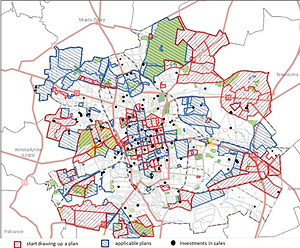Current issue
Online first
Archive
About the Journal
Aims and scope
Editorial Board
International Editorial Board
List of Reviewers
Abstracting and indexing
Ethical standards and procedures
REMV in Social Media
Contact
Instructions for Authors
Instructions for Authors
Manuscript formatting template
Title page
Highlights
Payments
‘Ghostwriting’ and ‘Guestauthorship’
Guidelines for Referees
Building and Biologically Active area Indices in Developers’ Investments – Theory and Practice
1
University of Łódź, Faculty of Economics and Sociology, Department of Investment and Real Estate
Submission date: 2021-03-04
Final revision date: 2021-09-06
Acceptance date: 2021-10-18
Publication date: 2022-03-17
Corresponding author
Agata Antczak - Stępniak
University of Łódź, Faculty of Economics and Sociology, Department of Investment and Real Estate
University of Łódź, Faculty of Economics and Sociology, Department of Investment and Real Estate
REMV; 2022;30(1):53-64
HIGHLIGHTS
- research has shown that in Łódź only few developers are investing in areas where local plans are in force, so the conducted analyses contained 21 investments in both analyzed years (2020 and 2021)
- it was assumed that most developers, as entities focused on profit, would use the built-up area to the maximum extent. Meanwhile, in eleven investments in 2020 and twelve in 2021, the analyzed indicator is lower than permissible, and in six of them in 2020 and in seven in 2021, it is even much lower than the parameters allowed by local plans (lower by 20 or more percentage points), so the situation related to the use of land for investment in Łódź seems to be slowly improving
- although the biologically active area indices in Łódź investments are mostly preserved, the form of their implementation leaves much to be desired. The predominant form is simply small lawns around buildings and thuja hedges. In one of the analyzed investments, solutions in the form of green terraces were used. Playgrounds are implemented only on larger plots located in the suburbs of the city
- therefore, it can be concluded that Łódź developers try to fulfill the provisions of local plans in terms of biologically active areas to the extent that allows them to obtain a building permit. Meanwhile, more should be done to ensure the sustainable development of cities
- therefore, it is the commune that has the obligation to pay attention to the needs of future generations. Cities should be very prudent in managing city-owned land, encouraging developers to maximize the use of built-up space on a smaller number of properties, while providing the biologically active space in a form other than just lawns
KEYWORDS
TOPICS
ABSTRACT
Development activity in Poland is regulated by many legal provisions, but one of the most important acts for the implementation of developers’ projects is the Act of March 27, 2003 on spatial planning and development. The Act includes, among others, procedures for the preparation and scope of local spatial development plans. One of the parameters significant from the point of view of housing development which these plans define is the minimum and maximum intensity of development and the percentage of biologically active space that should be preserved on a property covered by the investment project. The article adopts two research goals. Firstly, it is an attempt to verify, using examples of selected developers, whether they, as profit-oriented entities, decide to develop the property as much as possible or to keep more undeveloped space, which is a more desirable phenomenon from the environmental point of view. Secondly, an attempt will be made to determine how developers in Poland create a biologically active surface in their projects. Based on desk research, it was found that, among the discussed cases, there is no evident tendency to maximize the permissible built-up areas and the created biologically active areas are sparse and not diversified.



